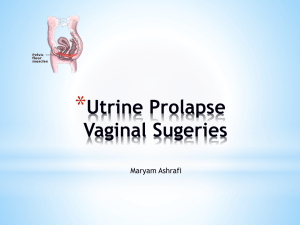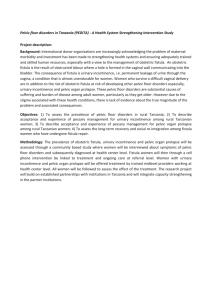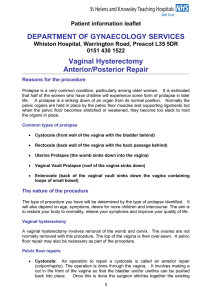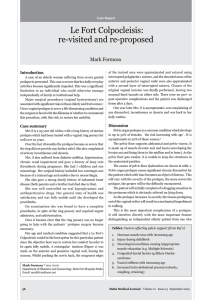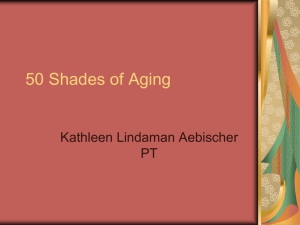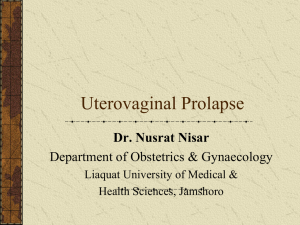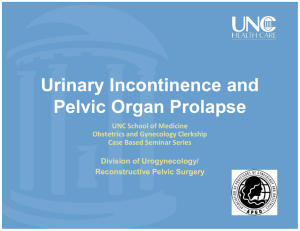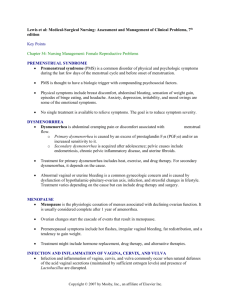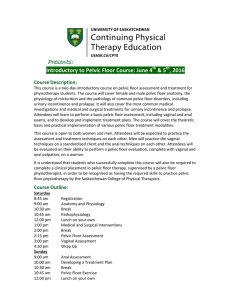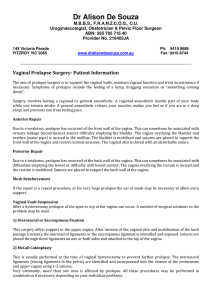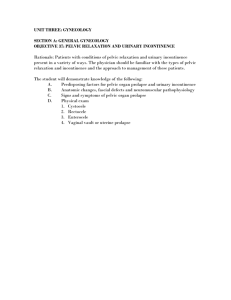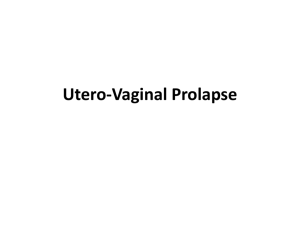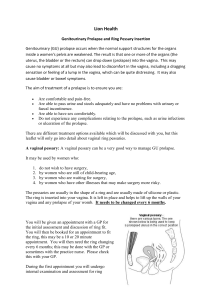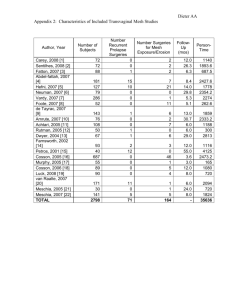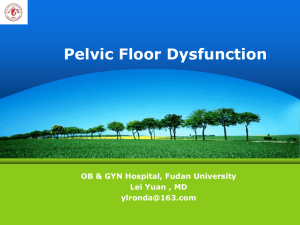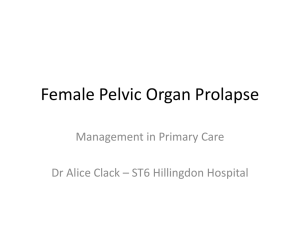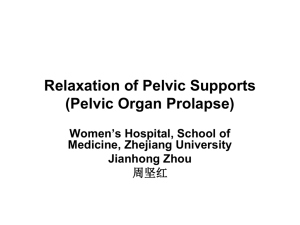Prolapse & Urogynaecology
advertisement
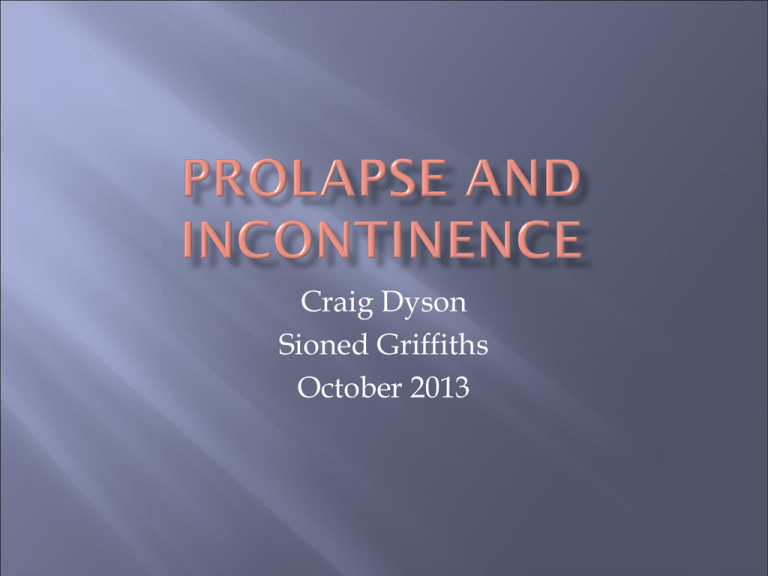
Craig Dyson Sioned Griffiths October 2013 Normal Anatomy Causes of prolapse Types of Prolapse Investigation Management • • • • • “To fall out” Protrusion of an organ or structure beyond its normal confines and with an epithelial surface Genitourinary prolapse – Descent of one or more of pelvic organs. 41% of 50-79 year old’s but uncertain Uterocoele, Cystocoele, Rectocoele, Enterocoele Levator Ani/Endopelvic Fascia important Damage to these structures can occur through: Trauma Neuropathic Injury Disruption/Stretching Multifactorial – Orientation of bones may be a factor. Increasing Age (Double risk with every decade) Vaginal Delivery Increasing parity Obesity Spina Bifida Pregnancy Variables Macrosomia Prolonged 2nd stage Episiotomy Use of forceps/oxytocin FH of prolapse Constipation Connective Tissue Disorder Occupation • • Anterior Urethrocoele Urinary Stress Incontinence – Rare – • Cystocoele Increased frequency – UTI – Sensation of mass – No Symptoms – • Both – Most Common • • • Middle Uterine Prolapse Vaginal Vault Prolapse Post Hysterectomy – Assoc with cystocoele, rectocoele and enterocoele. – Retention – • Enterocoele Pouch of Douglas – Cough Impulse – Posterior Rectocoele • • • • • • • Pelvic Organ Prolapse Quantification System Valsalva - ? Left Lateral Stage 0 Stage 1 – 1cm above hymen Stage 2 - Within 1 cm of hymen Stage 3 - >1cm below plane of hymen but <2cm of total length of vagina Stage 4 – Complete eversion of vagina • General – – – • Urinary – – • Incontinence Frequency Coital – – • Fullness Sensation of bulge Backache Dypareunia Flatus Bowel – – Constipation/Incontinence Need to apply digital pressure History and Examination Urinalysis Post-Voidal Urine volume testing Urodynamics US Urea/Creatinine Conservative Watchful Waiting Lifestyle Modification Pelvic Floor Exercises Evidence? Vaginal Oestrogen Creams Pessary Inserted into vagina to reduce prolapse Made of silicon or plastic or Soaked in wine… Good short term option Surgical Effective Re-operation required in 29% of cases Fitness of patient Sexually Active Surgeons Advice • Anterior Colporrhaphy – • • Hysterectomy Sacrospinous Fixation – • Involves plication of anterior vaginal wall to reinforce. Unilateral or bilateral fixation of uterus to sacrospinous ligament Sacocolpoplexy – Mesh used to attach top of vagina to sacrum. Prolapse is increasingly common with age. Can be classified according to compartment or level of prolapse Can be clear on examination Good conservative and surgical options available Good prognosis Pessary treatment for pelvic organ prolapse and health-related quality of life: a review. Lamers BH, Broekman BM, Milani AL - Int Urogynecol J (2011) Rev Urol. 2004; 6(Suppl 5): S2–S10. PMCID: PMC1472875. Female Pelvic Floor Anatomy: The Pelvic Floor, Supporting Structures, and Pelvic Organs. Sender Herschorn Herschorn S, Carr LK. In: Campbell’s Urology. 2002:1092–1139. Rectocele | Vaginal Surgery & Urogynecology Institute .vaginalsurgeryandurogynecologyinstitute.com Int J Med Sci 2012; 9(10):894-900. doi:10.7150/ijms.4829. Three-dimensional Ultrasound Appearance of Pelvic Floor in Nulliparous Women and Pelvic Organ Prolapse Women. Tao Ying Corresponding address, Qin Li, Lian Xu, Feifei Liu, Bing Hu http://www.patient.co.uk/health/Genitourinary-GU-Prolapse.htm www.pelvicfloor.com/knowledge/imagelibrary/1/img/1.jpg www.bristolsurgery.com/images/Preop%20Rectocele.jpg
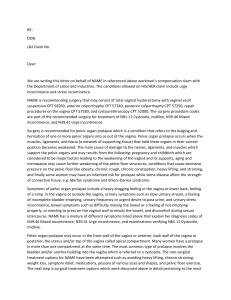
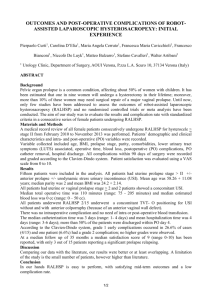
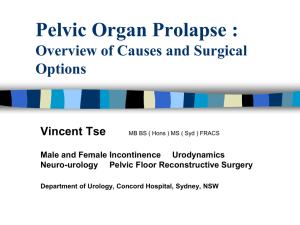
![MCQs Prolapse [PPT]](http://s2.studylib.net/store/data/009919194_1-700829bcb6ca1de78812c42b927c23d6-300x300.png)
